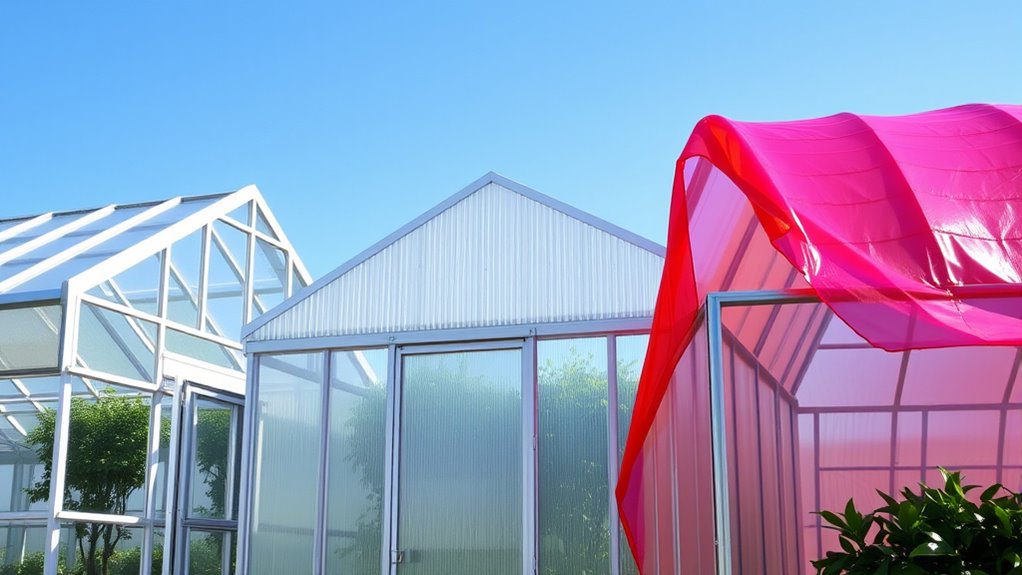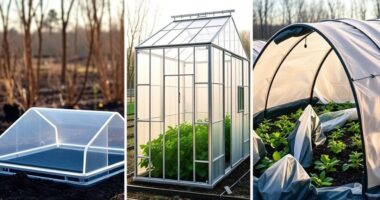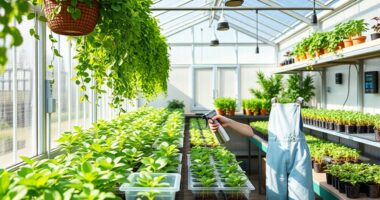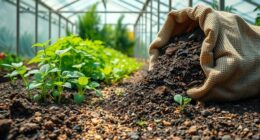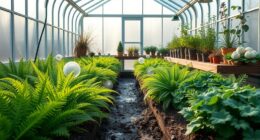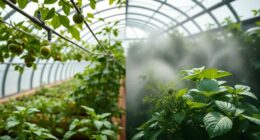When choosing a greenhouse covering, consider how each material affects light, durability, cost, and pest control. Glass offers excellent clarity and maximum light but is more fragile and costly, while plastic covers like polycarbonate are impact-resistant and more affordable, though they may slightly reduce light quality. Plastic also makes it easier to manage ventilation and pest control. To optimize your setup, understanding these differences can help you select the best option for your climate and budget.
Key Takeaways
- Glass offers superior light transmission and clarity but is more fragile and costly than plastic options.
- Plastic covers like polycarbonate provide better impact resistance, flexibility, and easier maintenance at a lower initial cost.
- Consider ventilation needs: plastic coverings are easier to modify for airflow, while glass requires additional systems.
- Climate and pest control strategies influence material choice; plastic covers facilitate integrated pest management.
- Evaluate budget, durability, and specific plant requirements to select the most suitable covering for your greenhouse.

Selecting the right greenhouse covering is essential for creating an ideal environment for your plants. The choice impacts not only light transmission and temperature regulation but also how you manage ventilation strategies and pest control methods. When weighing your options, consider how each material influences airflow. For example, glass offers excellent clarity but can limit natural ventilation unless paired with vents or fans. Polyethylene and other plastic covers tend to be more flexible, allowing you to incorporate adjustable openings easily. Proper ventilation is critical because it prevents overheating, reduces humidity, and minimizes pest issues that thrive in stagnant air. Choosing a covering that supports efficient airflow helps you maintain a stable environment, reducing the need for extensive pest control treatments.
Choosing the right greenhouse covering enhances airflow, controls pests, and creates optimal growing conditions.
Glass is a popular choice for greenhouses because of its durability and high light transmittance. However, it’s important to recognize that glass doesn’t naturally promote airflow. To enhance ventilation strategies, you’ll need to install operable vents or exhaust fans. Without these, the greenhouse can quickly become too hot in summer or damp in winter, creating conditions that attract pests such as aphids, whiteflies, or spider mites. Managing pests effectively becomes more challenging if airflow is restricted, so it’s crucial to plan for good circulation from the start. Glass also tends to be more expensive and fragile, which might influence your decision if budget or safety are concerns. Still, its clarity helps ensure your plants get the maximum sunlight, fostering healthy growth.
Poly coverings, such as polycarbonate or polyethylene film, are more versatile and easier to adapt for ventilation strategies. They allow you to install side vents, roof vents, or roll-up walls, giving you greater control over airflow. This flexibility can help you quickly respond to temperature spikes or humidity buildup, reducing pests that prefer warm, moist environments. Additionally, plastic covers typically cost less than glass and are less prone to breakage, making them a practical choice for many growers. They also tend to promote better pest control methods, as you can design the greenhouse with integrated screens or barriers to keep pests out while maintaining good airflow. Properly managing ventilation with plastic covers ensures your plants stay healthy and pest-free.
Ultimately, your choice of greenhouse covering should align with your climate, budget, and management style. Glass might be ideal if you prioritize maximum light and don’t mind installing additional ventilation equipment. Plastic coverings are excellent for those seeking cost-effective, adaptable options that facilitate better airflow management. By paying close attention to ventilation strategies and pest control methods, you can create a thriving environment tailored to your plants’ needs. The right covering, combined with effective airflow management, helps you reduce pest problems and maintain ideal growing conditions, ensuring a successful greenhouse operation.
Frequently Asked Questions
How Do Insulation Properties Differ Among Glass, Poly, and Plastic Covers?
You’ll find that poly and plastic covers generally offer better thermal efficiency than glass, helping keep your greenhouse warmer with less heat loss. They also excel at condensation control, reducing moisture buildup that can harm plants. Glass, while providing good clarity, isn’t as effective insulator-wise and may require additional heating. By choosing poly or plastic, you improve insulation and minimize condensation issues, creating a more stable environment for your plants.
Which Covering Offers the Best UV Protection for Plants?
If you’re aiming to shield your plants from UV rays without sacrificing light transmission, polycarbonate covers are your best bet. They excel at UV filtering, blocking harmful rays while letting in enough light for photosynthesis. Glass might look fancy, but it often lets in more UV, risking plant stress. Plastic covers vary, but many compromise UV protection for durability. Choose polycarbonate for a balanced mix of UV filtering and light transmission.
How Resistant Are These Materials to Extreme Weather Conditions?
You’ll find that glass is highly resistant to storm resilience and offers excellent durability under extreme weather, but it can break more easily. Polycarbonate is tough, flexible, and withstands strong winds and hail better, making it ideal for storm-prone areas. Plastic films, while lightweight and affordable, tend to be less durable under harsh conditions. Consider your climate to choose a covering that’s best suited for extreme weather resilience.
What Are the Maintenance Requirements for Each Greenhouse Covering?
You should establish regular cleaning routines for each covering—glass, poly, or plastic—to keep them clear and maximize light transmission. Glass often needs gentle cleaning and occasional repairs for cracks or chips, while poly and plastic covers require checking for tears or cloudiness and replacing damaged sections. Maintaining these surfaces guarantees their durability, preserves insulation, and prevents costly repairs down the line, ultimately extending your greenhouse’s lifespan.
How Do Costs Compare Over the Lifespan of Each Material?
Did you know that over a 10-year lifespan, glass greenhouses typically cost around 30% more than poly options? For a cost comparison, poly tends to be cheaper upfront and requires less maintenance, lowering long-term expenses. Glass offers durability but costs more initially and may need repairs. A lifespan analysis shows that plastic covers are the most budget-friendly, but they may need replacement sooner, affecting overall costs.
Conclusion
Choosing the right greenhouse covering is like selecting a window to your plants’ future. Glass offers clarity and strength, like a clear sky that nurtures growth. Polyethylene wraps your crops in a gentle embrace, flexible and resilient, whispering promises of protection. Plastic, versatile and adaptable, mirrors the changing seasons. Your choice shapes the environment—your greenhouse’s heart. Trust your instinct, and let your covering be the window through which your plants reach for the sun, thriving in harmony.
